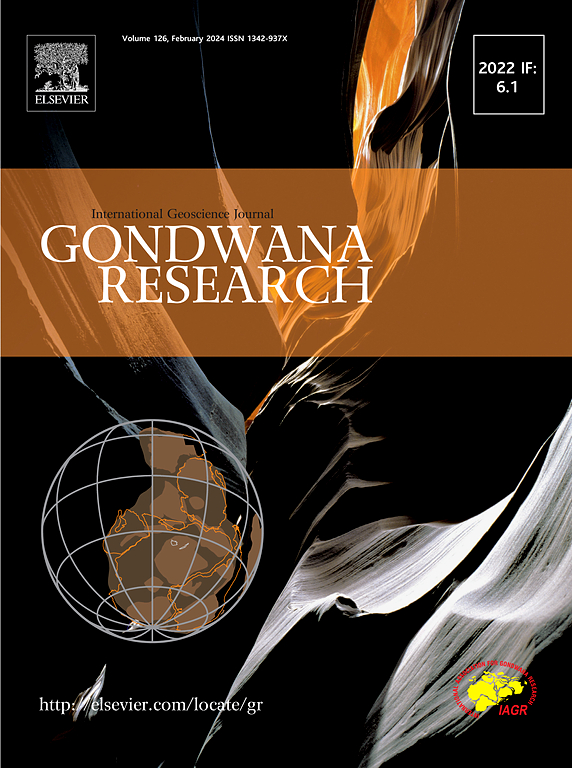东冈瓦纳造山带的微大陆碰撞:来自地质、地球化学和地质年代学的证据:东南极洲l佐-霍尔姆杂岩碰撞边界“Berrnabbane”
IF 7.2
1区 地球科学
Q1 GEOSCIENCES, MULTIDISCIPLINARY
引用次数: 0
摘要
本研究的重点是东冈瓦纳造山带内德龙宁毛德地东部吕措-霍尔姆岩群西部尚未勘探的露头 "Berrnabbane"。从这个小露头中发现了不同的原岩年龄,可将其视为大面积吕措-霍尔姆岩群的小规模类似物。这些不同原岩年龄的岩石相互接触,没有明显的剪切带。中部至南部由原岩年龄为 2.5 Ga 的长英片麻岩组成。这些岩石源于最初岛弧构造环境下板块熔融形成的微型大陆。贝尔纳班中部包括原岩年龄为1.9 Ga的长英片麻岩和黑云母花岗岩。这些岩石被包裹在辉长片麻岩中,最大沉积年龄为1.8 Ga。这些岩石与大陆边缘弧相对应,包括围绕 2.5 Ga 微大陆边缘发育的增生棱岩。北部由原岩年龄为 1.0 Ga 的长英片麻岩组成,源自另一块幼年大陆。2.5Ga大陆(边缘有1.9-1.8Ga的再加工)和1.0Ga大陆的岩石变质持续时间不同。两者都经历了550-500Ma的变质过程,而只有2.5Ga大陆保留了600Ma以前的热变质过程。较早的事件可能是 2.5 Ga 小洲碰撞并埋藏在 1.0 Ga 大洲之下造成的地壳增厚,而较晚的事件应该是被称为 Kuunga 造山运动的板块碰撞。仅在 2.5 Ga 的微大陆上保留的长时间造山运动表明,辐射产热在东冈瓦纳造山运动的极高温变质作用中发挥了重要作用。目前的研究结果表明,在冈瓦纳混杂时期,吕佐夫-霍尔姆复合体与斯里兰卡复合体的关系比与德龙宁毛德地的其他复合体的关系更为密切。本文章由计算机程序翻译,如有差异,请以英文原文为准。

Microcontinental collision in the East Gondwana orogen: Evidence from geology, geochemistry, and geochronology of the collision boundary “Berrnabbane” in the Lützow-Holm Complex, East Antarctica
This study focuses on the unexplored outcrop “Berrnabbane” in the western Lützow-Holm Complex, eastern Dronning Maud Land within East Gondwana orogen. Various protolith ages are identified from the small outcrop, which can be considered as small-scale analogs of the extensive Lützow-Holm Complex. These rocks with different protolith ages are in contact with each other without obvious shear zones. The central to the southern part is composed of felsic gneiss with a protolith age of 2.5 Ga. These rocks are derived from a microcontinent formed by slab melting in an initial island arc tectonic setting. The central Berrnabbane includes felsic gneiss and mafic granulite with a protolith age of 1.9 Ga. These rocks are enclosed within pelitic gneiss, with a maximum depositional age of 1.8 Ga. These rocks correspond to the continental margin arc, including an accretionary prism developed around the 2.5 Ga microcontinental margin. The northern part comprises felsic gneiss with a protolith age of 1.0 Ga, which originated from another juvenile continent. The duration of metamorphism differs between rocks with the 2.5 Ga (with 1.9–1.8 Ga reworked margin) and the 1.0 Ga continents. Both share the event during 550–500 Ma, whereas only the 2.5 Ga continent preserves former thermal events from ∼ 600 Ma. The earlier event might be the crustal thickening caused by the collision and burial of the 2.5 Ga microcontinent beneath the 1.0 Ga continent, and the latter event should be a cratonic collision known as the Kuunga Orogeny. The prolonged orogenesis preserved only in the 2.5 Ga microcontinent suggests that radiogenic heat production would play an important role in extremely high-temperature metamorphism in the East Gondwana orogeny. The present results indicate that the Lützow-Holm Complex correlates more closely with the Sri Lankan Complexes than with other complexes in Dronning Maud Land during the amalgamation of Gondwana.
求助全文
通过发布文献求助,成功后即可免费获取论文全文。
去求助
来源期刊

Gondwana Research
地学-地球科学综合
CiteScore
12.90
自引率
6.60%
发文量
298
审稿时长
65 days
期刊介绍:
Gondwana Research (GR) is an International Journal aimed to promote high quality research publications on all topics related to solid Earth, particularly with reference to the origin and evolution of continents, continental assemblies and their resources. GR is an "all earth science" journal with no restrictions on geological time, terrane or theme and covers a wide spectrum of topics in geosciences such as geology, geomorphology, palaeontology, structure, petrology, geochemistry, stable isotopes, geochronology, economic geology, exploration geology, engineering geology, geophysics, and environmental geology among other themes, and provides an appropriate forum to integrate studies from different disciplines and different terrains. In addition to regular articles and thematic issues, the journal invites high profile state-of-the-art reviews on thrust area topics for its column, ''GR FOCUS''. Focus articles include short biographies and photographs of the authors. Short articles (within ten printed pages) for rapid publication reporting important discoveries or innovative models of global interest will be considered under the category ''GR LETTERS''.
 求助内容:
求助内容: 应助结果提醒方式:
应助结果提醒方式:


